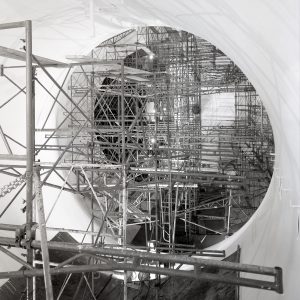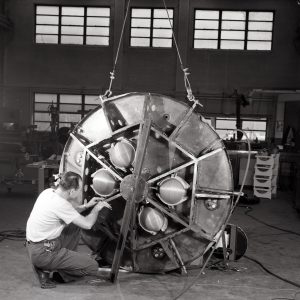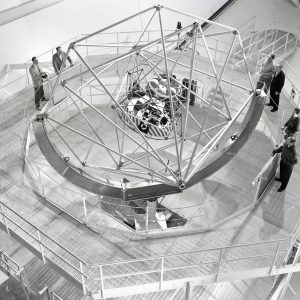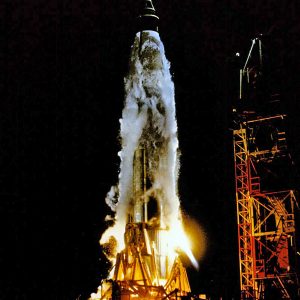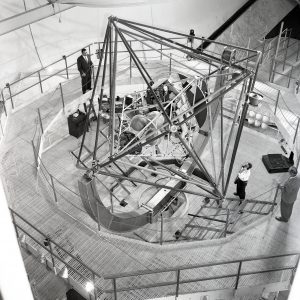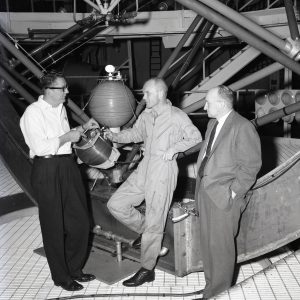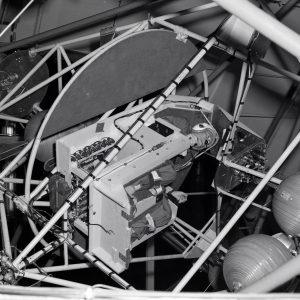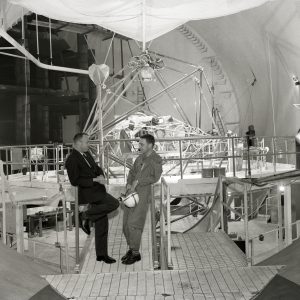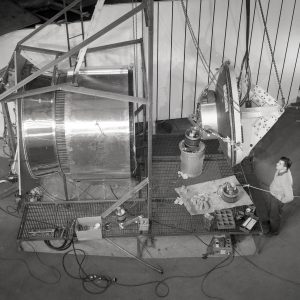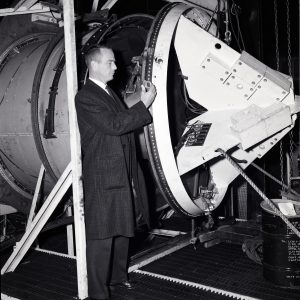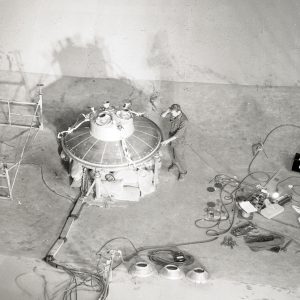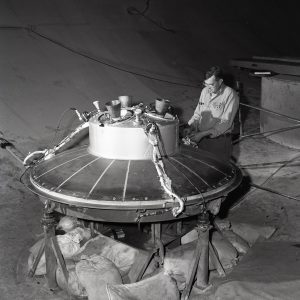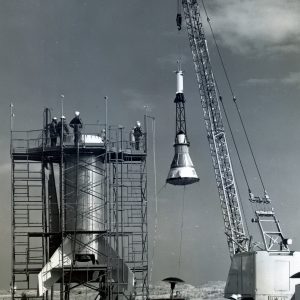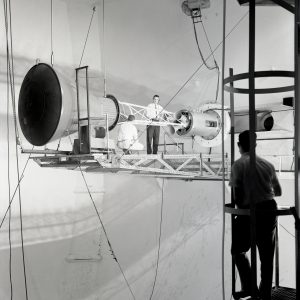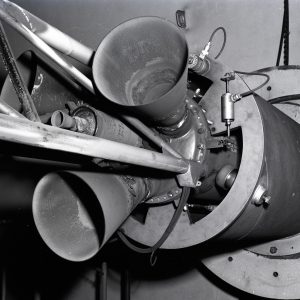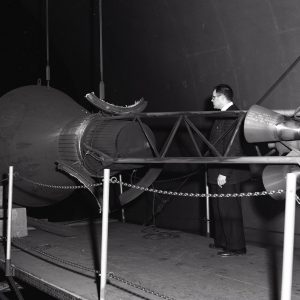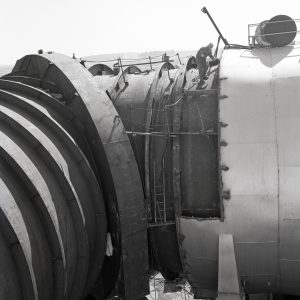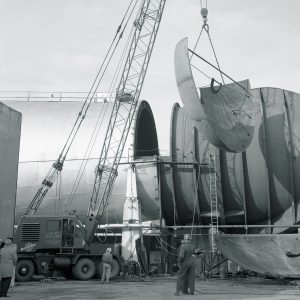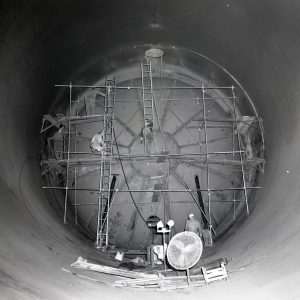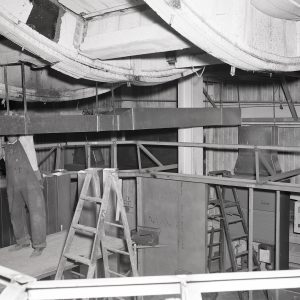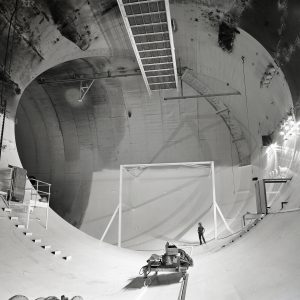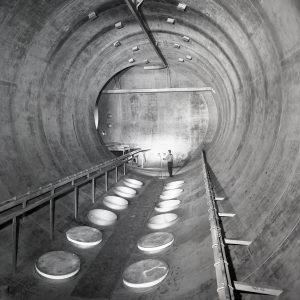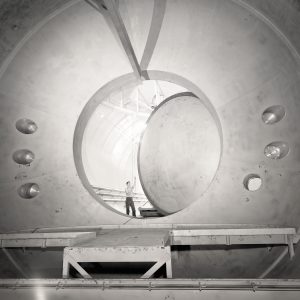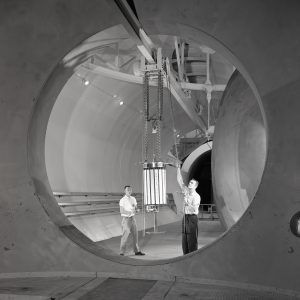AWT Enters the Space Age
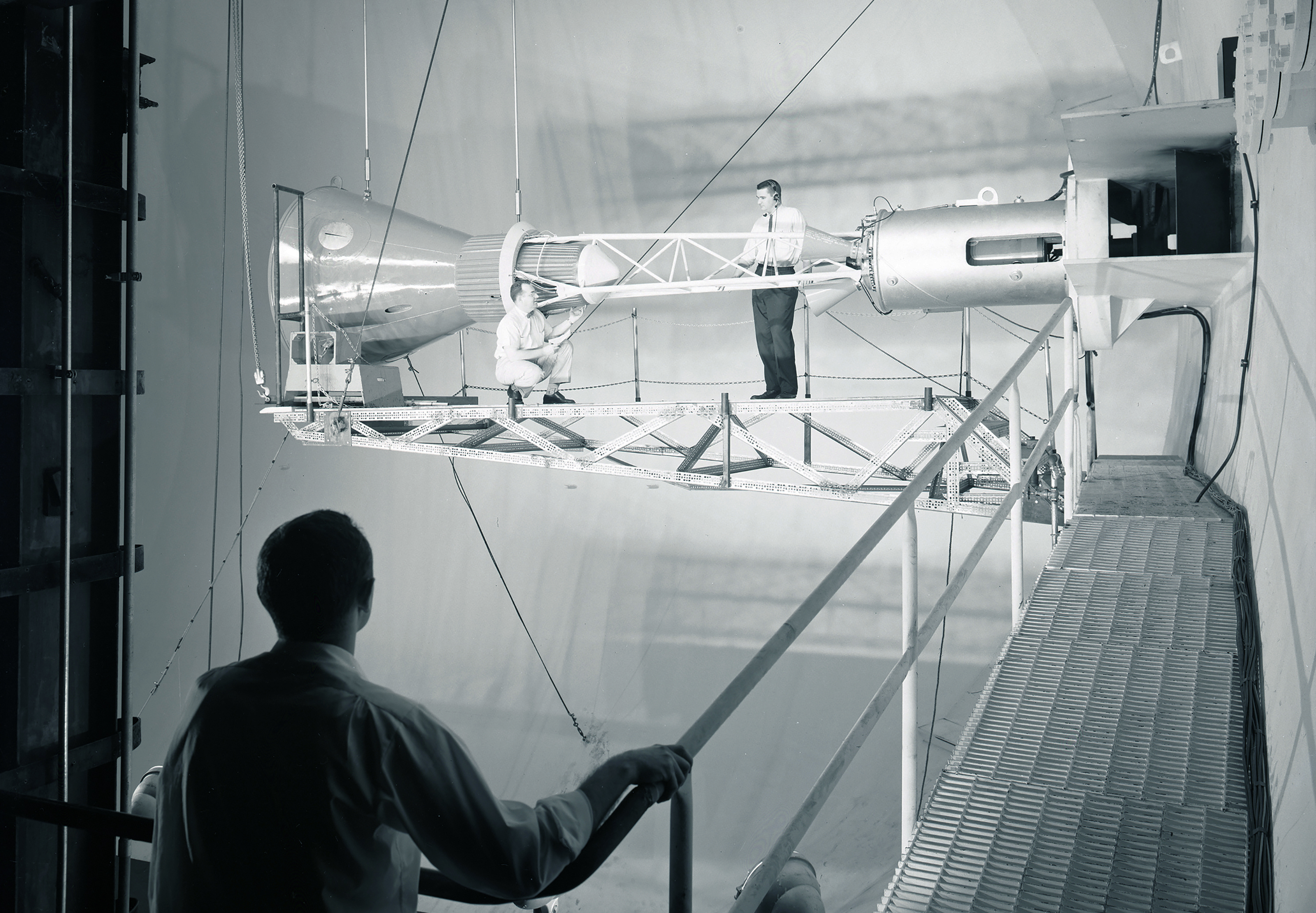
In the early 1960s, NASA modified the AWT to address the needs of the burgeoning space program. The facility first supported Project Mercury, then was permanently transformed into two large altitude chambers.
Overview
The Soviet Union’s launch of Sputnik in October 1957 ushered in a new era for the NACA and its Lewis Flight Propulsion Laboratory. The lab had added several new propulsion test facilities in the 1950s that decreased the usage of the Altitude Wind Tunnel (AWT). So, when Lewis became part of the new U.S. space agency in 1958, its engineers sought ways to apply the facility to its rapidly expanding space activities. The AWT’s final use as wind tunnel involved testing of high-pressure solid rockets in altitude conditions.
In May 1959, the National Aeronautics and Space Administration (NASA) elected to use the AWT’s altitude capabilities to test the control systems for a boilerplate capsule for Project Mercury. The equipment would not fit in the tunnel’s test section, so Lewis engineers agreed to remove the internal components to create a large chamber in the wide end of the tunnel. In October 1959 the agency assigned Lewis several additional Mercury test programs for the AWT chamber. Afterwards, center leaders decided to remove the internal components from the other end of the tunnel and permanently convert the facility into two high-altitude test chambers. The transformation from the AWT to the Space Power Chambers (SPC) was completed in 1962. The SPC’s physical attributes are described here.
Documents
- Performance of Solid Propellant at High Altitudes (1959)
- Project Mercury Chronology (1944-63)
- This New Ocean: A History of Project Mercury (1966)
- Project Mercury Archives
AWT Modified for Big Joe
In 1959 NASA planned its first launch attempt for Project Mercury. The mission, referred to as Big Joe, would use a new Atlas missile to launch a boilerplate Mercury into the edge of space to simulate re-entry and test the launch and recovery processes. Lewis fabricated the capsule’s lower section, which contained the electronics and retrorocket tanks, the automatic stabilization system, and assembled the complete capsule.
NASA needed to calibrate Big Joe’s autopilot and attitude control systems in the high altitudes in which it would operate. The systems were critical to the mission since a failure to properly orientate the spacecraft would result in the capsule’s destruction during re-entry. It was decided to use the vast interior of the AWT to set up the test equipment. The center removed the tunnel’s turning vanes and make-up air pipes were extricated from the western leg forming a 121-foot-long, 51-foot-diameter chamber. Elevated walkways and banks of lights were erected along the western wall.
NASA engineers design a unique device called the Multi-Axis Spin Test Inertial Facility (MASTIF) inside the chamber to test the Big Joe control system. The MASTIF consisted of three cages that pivoted, or “gimbaled,” on a stand near the tunnel’s throat section. The rig then spun on three axes from 2 to 50 rotations per minute. The test operators set the rig spinning in three directions simultaneously, then activated the control system that automatically fired thrusters to stabilize the capsule. The series of AWT tests in spring 1959 successfully verified the stabilization system’s performance. The September 9, 1959 launch of Big Joe proved to be a success despite issues with the Atlas booster.
Documents
Astronaut Training in the MASTIF
NASA decided to expand the gimballing platform that had been set up in the AWT for Big Joe to contribute to the extensive physical testing of the Mercury astronauts. In late 1959, NASA engineers added a foam couch, a hand controller, and an instrument display to center of the MASTIF to train the astronauts how to reorientate a tumbling out-of-control spacecraft. The three-axis rig could simultaneously spin the astronauts head over heels, roll them sideways, and spin them horizontally. The trainee used the hand controllers to activate small nitrogen gas thrusters on the outer sections of the rig to try to bring the MASTIF under control. (Video of the MASTIF can be viewed here).
In February and March 1960, the seven Mercury Program astronauts and several pilots (including Jerrie Cobb) traveled to Lewis to train on the MASTIF. An astronaut was secured in a foam couch in the center of the rig. The pilots were tested on each of the three axis individually, then all three simultaneously at speed up to 70 rotations per minute. The researchers and military physicians closely monitored the tests, which left many of the trainees nauseous.
Early tests revealed that astronauts responded well to disorientation on any one axis, but responses flagged as the second and third axes were introduced. Nonetheless, the astronauts acclimated themselves to motions over time and were able to perform manual and mental tasks at 70 rotations per minute. The researchers also found that the astronauts could reduce the effects of nystagmus (rapid, involuntary side-to-side eye movement) by staring at a single point.
Documents
- Newsletter Articles on MASTIF (1960)
- Pilot Reaction to High-Speed Rotation (1963)
- Astronaut Press Conference at Lewis (1960)
- MASTIF Description (1962)
- MASTIF Space Progress Report (1959)
Mercury Retrorocket Tests
The Mercury capsule had six rockets on a “retro-package” affixed to the bottom of the capsule. Its three posigrade rockets separated the capsule from the booster during launch, and its three retrograde thrusters slowed the capsule for reentry into Earth’s atmosphere. The retrorockets experienced a number of problems during early qualification tests. In 1959, NASA asked Lewis to help resolve the issue.
In early 1960 Lewis researchers conducted tests of a full-scale retropackage with mockups of Redstone and Atlas boosters in the AWT’s new altitude chamber. The capsule was affixed horizontally to the booster equipment. Once the posigrade rockets fired, the capsule jettisoned forward on a tether as high-speed cameras filmed the separations. The tests provided important thrust data and verified that the retrorockets would not damage the booster.
The qualification of the retrograde thrusters began in April 1960 in the AWT. Mechanics installed the capsule’s retropackage on a thrust stand in the southwest corner of the tunnel sot that the three retrograde thrusters fired vertically into the air. Initial tests verified the modifications to the thruster design eliminated ignition delays. Ensuing runs examined the attachment of the coated igniter to the propellant grain. The researchers also calibrated the system so the firing of the retrorockets would not alter the capsule’s position.
Documents
Mercury Escape Rocket Tests
The Mercury capsule had a 10-foot steel tower with a cluster of three rockets at the tip. These rockets could jettison the crew to safety in the event of launch vehicle malfunction at any point between prelaunch and the separation. Once away from the rocket, spacecraft jettisoned the escape tower and parachuted into the sea.
In the early summer of 1960 Lewis used the AWT chamber to qualify escape rocket motors and determine if their exhaust plume would shroud the spacecraft. Technicians mounted the tower and capsule model to a make-up air pipe near the southwest corner of the AWT. Researchers successfully fired the system’s three rockets at simulated altitudes of 100,000 feet. They also analyzed thrust misalignment by testing one motor on a four-component balance system. The team concluded that the escape tower rockets met operational requirements.
Transformation into the SPC
After the Mercury tests concluded near the end of May 1960, Lewis decided to construct two test chambers within the AWT shell—one capable of simulating the altitudes of outer space, the other of Earth’s upper atmosphere. At the time there were no large vacuum tanks in the United States. Initial missions in the late 1950s revealed conditions in space affected the behavior of engines, flight systems, and hardware.
Construction began in early summer of 1961 and was completed in a little over a year. The tunnel’s drive shaft, fan, turning vanes, and exhaust scoop were removed from the east end. Three bulkheads were installed inside the tunnel to create the two chambers: the high-vacuum SPC No. 1 in the eastern leg and the larger SPC No. 2 in the in the remainder of the tunnel. The work included the rewilding of the exterior shell of the east end and construction of a Vacuum Pump House underneath to store the diffusion pumps used to lower the chamber’s pressure to a simulated 100 miles altitude. Removal of the test section lid and construction of a metal bridge erected across the chasm made the area accessible. A new control room for SPC No. 1 was created underneath the tunnel test section. The existing wind tunnel control room was modified to run the tests in SPC No. 2.
The facility was officially renamed the Space Power Chambers (SPC) on September 12, 1962. Although NASA would later construct larger chambers, the rapid conversion of the AWT allowed the SPC to play an important role in the early years of the space program. Just a month after the completion of the SPC, NASA transferred the troubled Centaur Program to Lewis. Lewis would use the SPC throughout the 1960s for a variety of Centaur tests.
Documents
- A Survey of Large Space Chambers (1963)
- SPC Alteration for Space Simulation (c1960)
- Memo Renaming AWT as SPC (1962)
- AWT Gets New Assignment article (1962)

